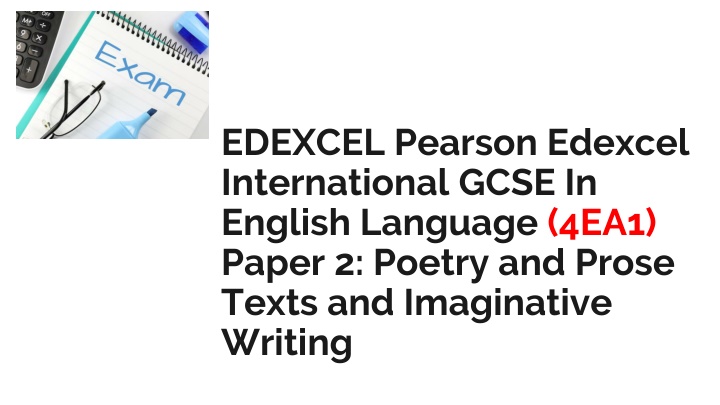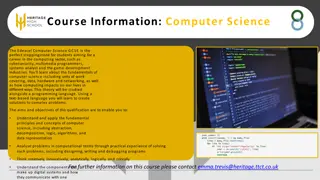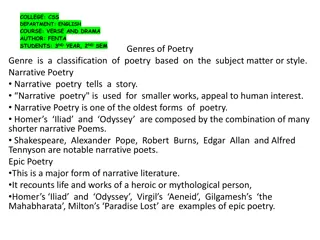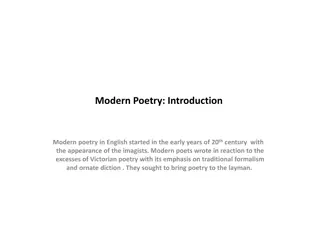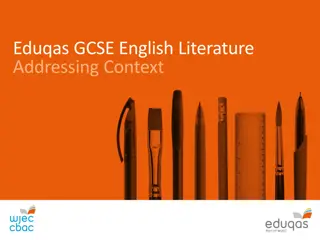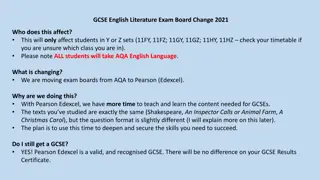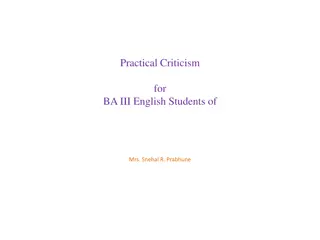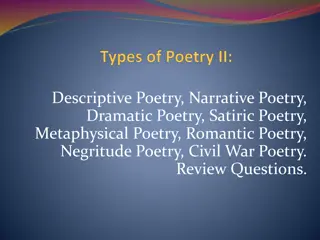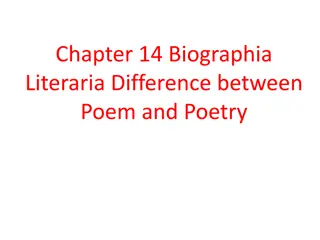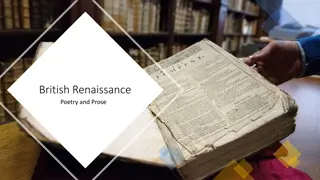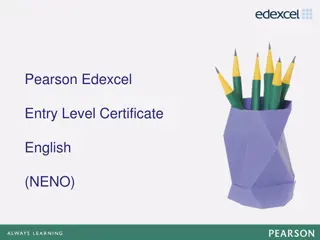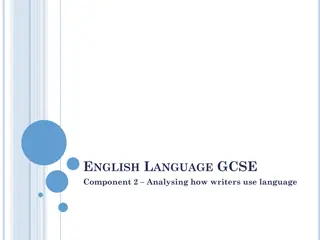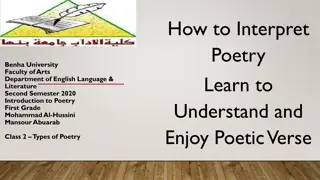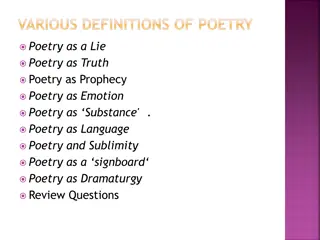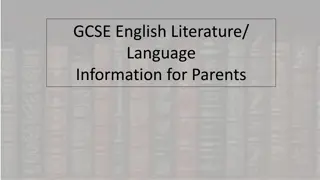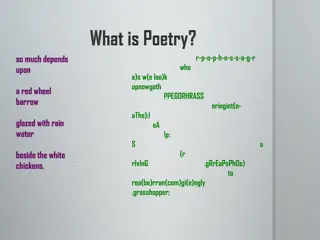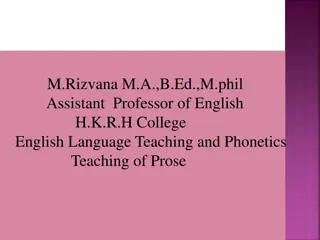Edexcel International GCSE in English Language Poetry & Prose
Dive into the world of poetry, prose texts, and imaginative writing with Edexcel's International GCSE English Language Paper 2. This exam focuses on enhancing your understanding and analysis of various literary works. Explore different themes, writing styles, and creative expressions through this comprehensive text. Prepare yourself for a unique learning experience that will sharpen your critical thinking skills and literary appreciation. Perfect for students looking to excel in English language studies and examinations.
Download Presentation

Please find below an Image/Link to download the presentation.
The content on the website is provided AS IS for your information and personal use only. It may not be sold, licensed, or shared on other websites without obtaining consent from the author.If you encounter any issues during the download, it is possible that the publisher has removed the file from their server.
You are allowed to download the files provided on this website for personal or commercial use, subject to the condition that they are used lawfully. All files are the property of their respective owners.
The content on the website is provided AS IS for your information and personal use only. It may not be sold, licensed, or shared on other websites without obtaining consent from the author.
E N D
Presentation Transcript
EDEXCEL Pearson Edexcel International GCSE In English Language (4EA1) Paper 2: Poetry and Prose Texts and Imaginative Writing
Paper 2 of Edexcel's IGCSE First Language English lasts for 1 hour30 minutes and has a total of 60 marks available. Section A Poetry and Prose Texts: (approximately 45 minutes): Candidates should study the poetry and prose provided in Part 2 of the Pearson Edexcel International GCSE English Anthology one essay question on a poetry or prose text Section B Imaginative Writing: (approximately 45 minutes): Candidates pick one out of three questions Usually, the questions are linked by theme to the reading prose extract or poem.
Q 1 study and analyse selections from a range of fictional poetry and prose texts Candidate should be able to read substantial pieces of writing (extended texts) that make significant demands on them in terms of content, structure and the quality of language. Throughout the qualification, candidates should develop the skills of inference and analysis. Must study from the Pearson Edexcel International GCSE English Anthology There are three bullet points to prompt the response the third bullet always asks candidates to consider language and structure.
Q 1 TOP Tips The questions in this section focus on how the author portrays specific characters or generates interest. Each question includes three prompts. In your response, you should address the following: The first two prompts are directly related to the question they concern the depiction of the narrator or events. How does the writer present . How does the writer create . The last prompt is the use of language and structure . You should refer to details from the text and incorporate brief quotations.
Past paper Q1 questions Disabled (Wilfred Owen) Jan-13, Jan-17, Jan-19R Out, Out (Robert Frost) Jun-12, Jun-16 An Unknown Girl (Moniza Alvi) Jun-15, 22 The Bright Lights of Sarajevo (Tony Harrison) Still I Rise (Maya Angelou) Jan-19, 23 The Story of An Hour (Kate Chopin) Jun-18 The Necklace (Guy de Maupassant) Jun-14R, Jan-18, Jun-18R Significant Cigarettes (The Road Home) Rose Tremain Whistle and I ll Come to You (The Woman in Black) Susan Hill Jun-19 Source: www.colourmylearning.com
Q1 model answer (disabled) How does the writer present the character of the soldier in Disabled? In your answer, you should write about: the soldier s thoughts and feelings how others react to him the use of language and structure. You should support your answer with close reference to the poem, including brief quotations.
Answer Q1 disabled (1/3) In Wilfred Owen's poem "Disabled," the character of the soldier is presented with a deep sense of loss, regret, and alienation. The poem intricately details his physical and emotional transformation due to the war, highlighting the stark contrast between his past vitality and his present condition. Owen employs imagery and tone to convey the soldier's profound sense of despair and isolation. The opening line, "He sat in a wheeled chair, waiting for dark," uses visual imagery to create a somber tone, emphasizing the soldier s passive and powerless state. Owen contrasts this with the soldier's memories of youthful vigor, filled with "football matches and romantic encounters," highlighting a sharp juxtaposition between his vibrant past and his current reality.
Answer Q1 disabled (2/3) The vivid description "legless, sewn short at elbow" employs stark imagery to underscore his physical disabilities. This vivid imagery reflects the soldier's acute awareness of his inability to experience the joys of his former life. His memories of "girls waists" and "warm... hands" are now tainted by similes, comparing their touch to "some queer disease." This metaphorical language shifts the depiction from vibrant physicality to emotional paralysis, underscoring his profound sense of loss and alienation. One can observe that once admired, the soldier is now met with pity or indifference, reflecting a stark contrast in societal attitudes. The girls who once admired him now avoid him, their eyes "passed from him to the strong men that were whole," using imagery to highlight his social and physical invisibility. This societal indifference contrasts sharply with the enthusiastic send-off he received, described with auditory imagery, "drafted out with drums and cheers." Now, only a "solemn man who brought him fruits" acknowledges him, and this gesture, laden with pity, lacks the previous admiration.
Answer Q1 disabled (3/3) In "Disabled," Owen uses vivid imagery, poignant contrasts, and the reactions of others to present the soldier as a tragic figure consumed by loss and regret. The poem serves as a powerful commentary on the devastating effects of war, not only on the body but also on the human spirit. Through literary techniques such as imagery, juxtaposition, and metaphor, Owen captures the profound physical and emotional impact of war on the individual, making "Disabled" a poignant reflection on the costs of conflict.
Example Q 2/3/4 (Model answer) Raising a teenager is one of the most difficult challenges in life. Write a leaflet for parents/carers that gives advice on how to help and guide teenagers. Your leaflet may include: what issues teenagers may face how parents/carers can best support teenagers any other points you wish to make.
Q 2/3/4 (pick 1) The objective of the question (you only answer one of them) is AO 4 communicate effectively and imaginatively, adapting form, tone and register of writing for specific purposes and audiences AO 5 write clearly, using a range of vocabulary and sentence structures, with appropriate paragraphing and accurate spelling, grammar and punctuation.
Model Answer (Q2/3/4) 1/3 Title:Navigating the Teenage Years: A Guide for Parents and Carers Raising a teenager is one of the most difficult challenges in life. As they transition from childhood to adulthood, teenagers face numerous changes and challenges that can be overwhelming for both them and their parents. This leaflet aims to provide practical advice and support for parents and carers to help guide their teenagers through these crucial years. Understanding the Issues Teenagers Face 1. Emotional Turmoil -Teenagers experience a whirlwind of emotions due to hormonal changes. They may feel confused, angry, or sad without understanding why. It's important to acknowledge these feelings as part of their development. 2. Peer Pressure-The desire to fit in can compel teenagers to make choices they wouldn t normally consider, including experimenting with substances or engaging in risky behaviors. Peer pressure can heavily influence their decisions. 3. Academic Stress-Balancing schoolwork, extracurricular activities, and social life can be stressful. The pressure to perform academically can lead to anxiety and self-doubt.
Model Answer (Q2/3/4) 2/3 Supporting Your Teenager 1. Open Communication-Maintain an open line of communication. Encourage your teenager to talk about their feelings and experiences without fear of judgment. Listening actively and empathetically can foster trust and understanding. 2. Set Boundaries with Flexibility-Establish clear rules and expectations while allowing room for flexibility. It s important to enforce boundaries but also to be willing to negotiate and adapt as your teenager matures. 3. Encourage Positive Activities-Encourage your teenager to participate in hobbies and activities that interest them. Positive activities can provide a healthy outlet for stress and help them develop skills and confidence. Additional Tips for Parents and Carers 1. Model Healthy Behaviors-Demonstrate healthy coping mechanisms, effective communication, and responsible behavior. Teenagers often learn by observing their parents. 2. Seek Professional Help When Needed-Don t hesitate to seek professional help if your teenager shows signs of mental health issues such as depression, anxiety, or severe behavioral changes. Consulting a counselor or therapist can provide additional support.
Model Answer (Q2/3/4) 3/3 Raising a teenager may indeed be one of life's most challenging tasks, but it is also one of the most rewarding. By understanding the issues they face and providing thoughtful, compassionate support, parents and carers can help their teenagers navigate these formative years successfully. Remember, the goal is to guide them toward becoming well-rounded, resilient, and independent adults. Resource: Website [ ] Hotline { ]
